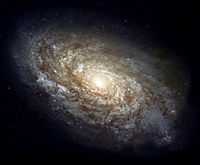Standard-candles astronomy/Quiz
< Standard-candles astronomy
Standard-candles astronomy is a lecture and an article about the astronomy techniques for finding and studying standard candles and standard-candle candidates. These are used to estimate distances beyond the capability of trigonometric parallax.
You are free to take this quiz based on standard-candles astronomy at any time.
To improve your score, read and study the lecture, the links contained within, listed under See also, and in the astronomy resources template. This should give you adequate background to get 100 %.
As a "learning by doing" resource, this quiz helps you to assess your knowledge and understanding of the information, and it is a quiz you may take over and over as a learning resource to improve your knowledge, understanding, test-taking skills, and your score.
A suggestion is to have the lecture available in a separate window.
To master the information and use only your memory while taking the quiz, try rewriting the information from more familiar points of view, or be creative with association.
Enjoy learning by doing!
Quiz
See also
External links
![]() This is a research project at http://en.wikiversity.org
This is a research project at http://en.wikiversity.org